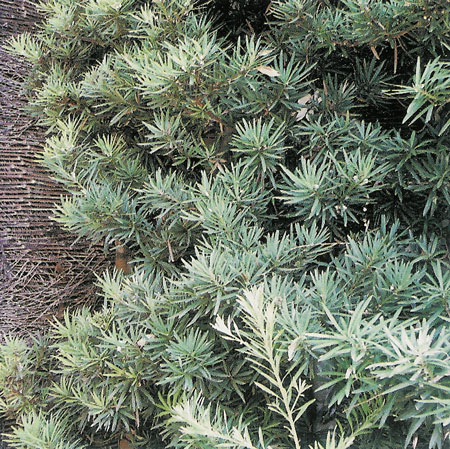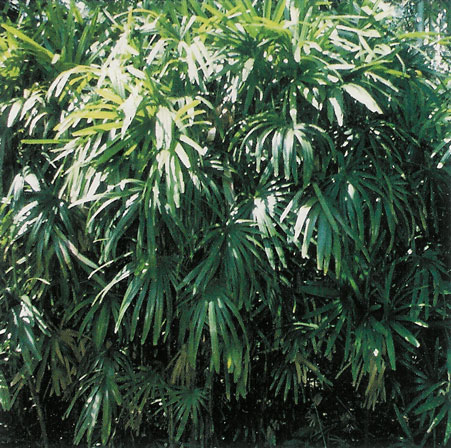
Cocculus laurifolius

Podocarpus macrophyllus
Best of Five Hedge Plants
text and photos by Scott Zona, Ph.D.
Cocculus laurifolius
Menispermaceae
Snail Seed
Plot 30
There is perhaps no finer hedge plant for South Florida than this large shrub. It is a much better choice than Ficus, which is difficult to control and has invasive roots. Cocculus grows rapidly but not uncontrollably, topping out at about 12 feet, it takes trimming well, and forms a dark, informal hedge — the perfect backdrop for plantings of flowering shrubs, crotons (Codiaeum cultivars) or palms. The flowers of Cocculus are insignificant, and in Florida, the flowers do not fotm fruits. It tolerates light shade.
Podocarpus macrophyllus
Podocarpaceae
Podocarpus
Plot 139
Tbis popular shrub can grow to about 20 feet tall, but it is easily pruned to 4 - 10 feet. The foliage is fine-textured, and the pale new growth in spring and summer contrasts pleasingly with the dark, mature foliage. It is a conifer and bears waxy, blue, berry-like cones instead of flowers. Not a rampant grower, Podocarpus should be given time to grow and establish before subjected to heavy pruning. It forms a dense, attractive, low-maintenance hedge well-suited to the formal clipped hedge style. It can tolerate light shade but is best in full sun.

Rhapis excelsa

Hamelia patens
Rhapis excelsa
Arecaceae
Lady Palm
Plots 52, 112 and 138
Palms are not often suitable for hedges, but Rhapis excelsa is the exception. If given plenty of moisture and room to grow, it forms an informal but elegant hedge, 6 - 8 feet tall, that shocld never be pruned. The dark, glossy foliage provides a rich tropical effect that no other hedge can surpass. Only occasional thinning or edging is needed to keep the hedge within bounds. It is an excellent choice for light shade. It is, however, expensive and somewhat slow-growing.
Hamelia patens
Rubiaceae
Firebush
Plots 19, 25, Jean duPont Shehan Visitor Center parking area
This Florida native is a freely flowering relative of Ixora, but it is much more tolerant of our alkaline soils. This shrub tops out at about 8 feet in full sun or light shade and is easily pruned. Once established, it is drought-tolerant. It propagates readily from cuttings. The leaves have an orangish tint, and bright red tubular flowers are attractive to butterflies and hummingbirds. Birds are attracted to the dark berries. Other native shrubs that make excellent informal hedges include Chrysobalanus icaco (salt tolerant!), Ardisia escallonioides, and Myrcianthes fragrans.

Carissa macrocarpa
Carissa macrocarpa
Apocynaceae
Natal Plum
The dark, glossy leaves and fragrant, white, pin-wheel flowers make Carissa a deservedly popular shrub. Dwarf and tall cultivars are available. As an informal hedge, it has an added benefit: the sharp, branched spines of Carissa make it an impenetrable barrier, well-suited to applications where additiorial security is desired. It needs full sun and is drought-tolerant. Care should be taken when pruning this plant and removing debris, since the spines are ferocious. Another spiny shrub that makes a good hedge is Severinia buxijolia.